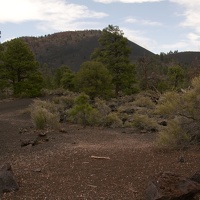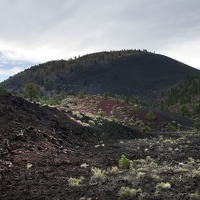 Sunset Crater rises before you, a nearly symmetrical cone. Its perfect shape suggests a simple eruption history, but that was not the case. In fact, it wasn't until the 1980s that scientists began to understand the complexity and extent of the eruption.
Sunset Crater rises before you, a nearly symmetrical cone. Its perfect shape suggests a simple eruption history, but that was not the case. In fact, it wasn't until the 1980s that scientists began to understand the complexity and extent of the eruption.
First, molten rock (magma) and gasses pushed up to the earth’s surface along a six-mile-long weak spot or fissure in the earth’s crust. Volcanic fragments, called pyroclasts, shot upward along the fissure in a “curtain of fire” as gasses escaped violently. Small cinder cones formed along this fissure before the magma became focuses and erupted as a lava fountain from a primary vent. A large cone (Sunset Crater) grew as the shower of cinders and ash piled up around the vent.
- Author
- Jamie Frees, Northern Arizona University Anthropology Laboratories
- File
- DSC_0723.jpg
- File size
- 1878 KB

